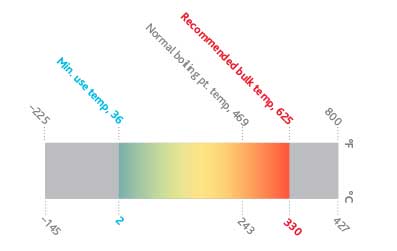Why Heat Transfer Fluid Is Vital for Optimizing Energy Transfer in Solution
The role of heat transfer liquids in maximizing energy transfer is pivotal for attaining reliable thermal administration across various commercial fields. These liquids assist in seamless heat exchange, making certain procedures operate within optimal temperature level varieties and reducing the risk of getting too hot.

Duty in Thermal Management
Warmth transfer liquids play a vital duty in thermal monitoring by effectively controling temperatures in various industrial procedures and systems. These specialized liquids promote the transfer of warm between different elements, guaranteeing optimal operating conditions and preventing getting too hot. By keeping exact temperature level control, warm transfer fluids enable sectors such as chemical production, oil and gas, and power generation to operate safely and efficiently.
The selection of a suitable heat transfer liquid relies on numerous aspects, consisting of thermal stability, heat capability, and viscosity. High thermal stability ensures that the liquid can hold up against severe temperatures without degrading, while a high warmth ability permits it to take in and release substantial quantities of warm - heat transfer fluid. Low thickness decreases the power needed for pumping, adding to general system efficiency
Furthermore, warm transfer liquids are indispensable in applications like refrigeration, where they assist absorb and dissipate warm throughout the cooling cycle. In solar thermal energy systems, these liquids capture and transport solar warm to create electrical energy or offer warm water. Their adaptability to varied operating problems and ability to keep consistent thermal performance emphasize their importance in commercial thermal monitoring, helping with functional connection and enhancing security actions.
Enhancing System Efficiency
To make best use of the benefits of thermal monitoring, enhancing system performance with the critical use of warmth transfer fluids is extremely important. These liquids play a critical function in optimizing energy transfer by promoting consistent thermal guideline, which in turn impacts the total performance and durability of systems. Reliable heat transfer causes minimized energy losses, minimized operational costs, and enhanced integrity of equipment. By preserving ideal temperature level levels, warm transfer liquids help guarantee that systems operate within their developed specifications, thereby stopping overheating and lowering the danger of part failure.

Sorts Of Heat Transfer Liquids
The variety of warmth transfer liquids emphasizes their vital duty in a variety of industrial applications, each tailored to meet specific thermal monitoring needs. These liquids assist in effective energy transfer and are selected based upon crucial residential or commercial properties such as thermal stability, thickness, and warm capability. The primary kinds consist of water, glycol services, oils, and synthetics, each offering distinct benefits.
Water is one of the most typical heat transfer tool because of its high specific warmth ability and low cost. Nonetheless, its usage is limited by its cold and steaming points. Glycol mixes, often utilized in heating and cooling systems, provide a reduced freezing point, including versatility in numerous climates. Mineral oils are preferred for their thermal stability and non-corrosive nature, making them suitable for high-temperature applications.

Artificial liquids, including silicone and aromatic substances, my explanation provide phenomenal thermal stability and are used in settings demanding severe temperature level ranges. These fluids make certain exceptional performance in systems where typical fluids may stop working. The selection of a heat transfer fluid is crucial, as it affects system performance, safety and security, and long life. Each kind must be chosen to align with the operational demands and the particular conditions of the application it offers.
Environmental and Economic Benefits
Using the best warm transfer fluids uses substantial ecological and economic benefits for commercial operations. Eco friendly warm transfer fluids, typically biodegradable and non-toxic, decrease the danger of soil and water contamination in the event of leakages or spills, thus securing communities and conforming with strict environmental guidelines.
Financially, the right warmth transfer fluid can dramatically reduce operational costs. Fluids with extensive lifecycle performance lower the regularity of replacements and upkeep, decreasing downtime and associated prices. Generally, the tactical use of optimal heat transfer fluids supports sustainable financial growth and environmental Read Full Article stewardship.
Picking the Right Fluid
Exactly how does one navigate the complicated procedure of selecting the right warmth transfer liquid for industrial applications? Thermal stability makes certain the liquid can hold up against high temperatures without deteriorating, while compatibility prevents deterioration or other damaging responses with system components.
In addition, the liquid's warmth capacity and thickness are vital. A high heat capacity enables the liquid to take in and move more energy, enhancing efficiency. At the same time, optimal viscosity makes sure marginal pump work and efficient heat transfer, particularly in visit this website differing temperatures. Environmental and safety and security facets need to additionally belong to the decision-making procedure. Non-toxic, naturally degradable liquids lower environmental influence and follow regulatory requirements, decreasing liability threats.
Final Thought
The strategic option and application of warmth transfer fluids are essential to optimizing energy transfer throughout various systems. By ensuring high thermal security and ability, these fluids provide specific temperature control and boost total system efficiency.